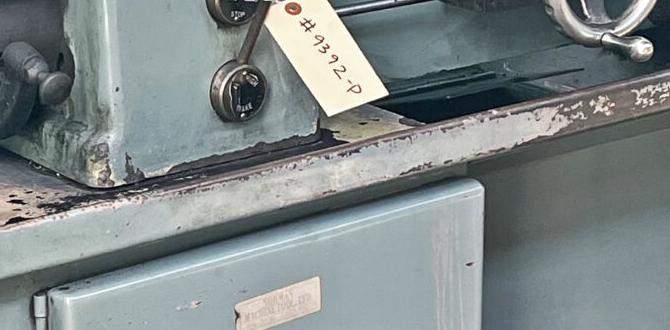Wood lathe workshop organization is key to a safer, more productive, and enjoyable woodworking experience. This guide provides actionable tips to declutter your space and arrange your tools, ensuring everything you need is within easy reach, making your creative process smoother and more efficient.
Having a messy workshop can be frustrating, right? Tools go missing, you trip over cords, and finding that one specific chisel feels like a scavenger hunt. It’s a common problem for woodworkers, especially those of us just starting out with our wood lathes. But don’t worry! A well-organized workshop isn’t just about appearances; it’s about making your hobby safer, more efficient, and a lot more fun. In this guide, we’ll walk through simple, effective ways to get your wood lathe area in tip-top shape, so you can focus on turning beautiful pieces without the clutter. Get ready to transform your workspace from chaotic to calm!
Wood Lathe Workshop Organization Tips: An Essential Guide for Beginners
Welcome to Lathe Hub! I’m Daniel Bates, and I’ve spent countless hours in workshops with both metal and wood lathes. I know what it’s like to have a space that feels more like a hazard zone than a creative sanctuary. That’s why I’m passionate about sharing practical tips to make woodworking accessible and enjoyable for everyone. Today, we’re diving into the world of wood lathe workshop organization. A tidy workspace is more than just neat; it’s a fundamental part of safe and efficient woodworking. It means less time searching for tools, fewer potential accidents, and more time actually making shavings! Let’s get your workshop set up for success.
Why Wood Lathe Workshop Organization Matters
Think about your favorite chef’s kitchen – everything in its place, ready for action. A woodworking shop, especially one centered around a wood lathe, can be the same. When your tools, accessories, and materials are well-organized, you gain several big advantages:
- Enhanced Safety: Reduced clutter means fewer tripping hazards. Knowing where your safety equipment is at all times is crucial.
- Improved Efficiency: Spend less time hunting for that specific gouge or sandpaper grit and more time turning.
- Better Workflow: A logical layout allows you to move smoothly between tasks, from rough turning to sanding and finishing.
- Tool Longevity: Proper storage protects your tools from damage, keeping them sharp and ready for use.
- Increased Enjoyment: A clean and organized space is simply more pleasant to work in, fostering creativity and reducing stress.
A cluttered workshop can lead to frustration and, more importantly, accidents. A sharp chisel left on a bench, a tangle of power cords, or a stack of lumber waiting to fall – these are all risks that good organization helps mitigate. For beginners, establishing good habits early on is invaluable. It sets the foundation for a lifetime of safe and rewarding woodworking.
Essential Workshop Zones for Your Wood Lathe Setup
To get organized, it helps to think of your workshop not just as one big space, but as a series of functional zones. This helps you dedicate specific areas for specific tasks and storage needs related to your wood lathe.
The Lathe Zone: Your Creative Hub
This is the heart of your operation. Your wood lathe should have ample space around it for safe operation and material handling. Consider these points:
- Clearance: Ensure you have plenty of room in front, behind, and to the sides of the lathe. You’ll need space to swing longer blanks and comfortably operate the lathe.
- Lighting: Good, focused lighting directly over the lathe is essential for safety and detail work.
- Power Access: Make sure power outlets are easily accessible but not where you’re likely to trip over cords. Consider a retractable cord reel.
- Tool Access: Your most-used lathe tools should be within arm’s reach.
Tool Storage Zone: Keeping Tools Handy and Protected
This is where you keep your chisels, gouges, parting tools, scrapers, and other turning implements. Organization here means faster access and better tool care.
- Magnetic Tool Holders: Excellent for quick access to metal tools like chisels and scrapers. Mount them on a wall near your lathe.
- Tool Chests or Drawer Units: Ideal for organizing a larger collection of tools. Use drawer liners and dividers to keep everything from rattling.
- Wall-Mounted Racks: Spesific racks for chisels and gouges can keep them safely stored with their cutting edges protected.
- Tool Rolls: Great for keeping sets of tools organized and portable.
Remember to store sharp tools with their edges protected. A dull tool is dangerous, and a damaged sharp tool is just as problematic. For more on sharpening, you might find resources from the Wood Turning Center helpful.
Material Storage Zone: Wood Within Reach
Where do you keep your turning blanks? Keeping them organized prevents a mountain of wood from taking over your space.
- Shelving: Sturdy shelves rated for the weight of lumber are a must. Store smaller blanks on higher shelves and larger ones lower down.
- Racks: Specialized lumber racks, whether wall-mounted or freestanding, are great for keeping things tidy and off the floor.
- Categorization: If you have different wood types or sizes, consider labeling shelves or using bins.
Keep your wood away from heat sources and damp areas to prevent cracking or warping. Proper storage extends the life of your wood and ensures you have a good selection ready for your next project.
Finishing and Accessory Zone: The Final Touches
This area is dedicated to your sanding supplies, finishes, rags, and other accessories. Keeping these items together streamlines the finishing process.
- Small Parts Organizers: Use bins or drawers for sandpaper, abrasives, transfer papers, and small finishing applicators.
- Shelf or Cabinet: Store your oils, waxes, lacquers, and rags safely. Ensure flammable finishes are stored according to safety guidelines.
- Bench Space: A small, dedicated bench area for applying finishes can be very useful.
Safety Equipment Zone: Ready and Visible
Your safety gear should never be hard to find. Designate a clear spot for your safety glasses, dust mask or respirator, hearing protection, and any first-aid supplies.
- Wall Hooks: Hang safety glasses, hearing protection, and dust masks on hooks in a prominent location.
- Clearly Labeled Box: Keep a well-stocked first-aid kit in an easily accessible cabinet or on a designated shelf.
Smart Storage Solutions Tailored for Woodworking Tools
Beyond general zones, let’s talk about specific storage solutions that really make a difference for wood lathe tools and accessories.
Lathe Tool Organizers
Your turning tools are your primary instruments. Keeping them organized and accessible is paramount.
- Wall-Mounted Holders: Many wood turners find success with custom-made or commercially available wall-mounted holders that cradle gouges and chisels. This keeps them visible and off the workbench.
- Tool Chests with Foam Inserts: For a higher level of protection and organization, consider cutting custom foam inserts for your turning tools in a rolling tool chest. This prevents them from banging against each other, keeping edges sharp.
- Magnetic Strips: While often associated with kitchen knives or metalworking tools, magnetic strips can be surprisingly effective for holding smaller metal turning tools like scrapers, parting tools, and even some smaller gouges, especially if they have a good amount of steel.
Sharpening Station Setup
A sharp tool is safe and effective. Your sharpening setup needs its own organized space.
- Dedicated Bench Space: Allocate a corner of a workbench or a dedicated small table for your grinder, honing guides, sharpening stones, and diamond plates.
- Dust Control: If using a grinder, ensure it’s connected to dust collection or is in an area where dust can be easily managed.
- Tool Protection: Keep honing compounds and strops organized, perhaps in a small drawer or on a dedicated shelf.
Learning to sharpen effectively is as important as learning to turn. Resources from organizations like Wood Magazine offer excellent insights.
Sawdust and Dust Collection
Woodworking generates dust. Proper organization includes managing it.
- Centralized Dust Collection: If possible, invest in a dust collection system. Ensure hoses and fittings are organized and not creating trip hazards.
- Vacuums and Brooms: Even without a full system, having a shop vacuum and broom readily available, with dedicated storage, makes cleanup efficient.
- Trash and Recycling Bins: Place bins strategically for wood scraps, finishes, and general waste.
Good dust management not only keeps your workshop clean but is vital for your health. The Occupational Safety and Health Administration (OSHA) provides guidelines on woodworking safety, including dust control, which are essential for any serious woodworker.
Creative Solutions for Small Woodworking Spaces
Not all of us are lucky enough to have sprawling workshops. If you’re working with limited space, clever organization is even more critical.
Vertical Storage is Your Friend
When floor space is limited, go up!
- Wall-Mounted Shelving: Install sturdy shelves high up for less frequently used items or lighter materials.
- Pegboards: Excellent for hanging a variety of tools, from clamps to smaller hand tools. Customize with hooks and bins.
- Overhead Storage: If your ceiling height allows, consider overhead shelves or cabinets for bulkier items.
Multi-Functional Furniture
Look for pieces that serve dual purposes.
- Workbench with Built-in Storage: A workbench with drawers and cabinets underneath maximizes your footprint.
- Rolling Carts: Mobile carts can be used to store tools or materials and can be moved out of the way when not in use, or brought closer to your workstation.
- Fold-Down Workbenches: For very tight spaces, a workbench that folds up against the wall when not in use can be a game-changer.
Clever Tool Storage Hacks
- PVC Pipe Organizers: Cut sections of PVC pipe and mount them to a wall or workbench to hold chisels, drill bits, or even small tool handles.
- Mason Jar Storage: Clear mason jars are perfect for organizing small hardware, screws, or finishing applicators. Label them clearly!
- DIY Tool Racks: With a bit of scrap wood and some creativity, you can build custom racks for your specific tools that fit perfectly into your available space.
Maintaining Your Organized Wood Lathe Workshop
Organization isn’t a one-time event; it’s an ongoing process. Here’s how to keep your workshop tidy:
The “Clean As You Go” Philosophy
- Put Tools Away Immediately: After using a tool, take the extra 10 seconds to return it to its designated spot.
- Wipe Down Surfaces: At the end of each turning session, take a moment to wipe down your lathe and workbench.
- Sweep or Vacuum Regularly: Don’t let sawdust build up. Daily touch-ups make deep cleaning much easier.
Schedule Regular “Shop Days” for Organization
Even with daily tidying, deeper organizational tasks will arise.
- Monthly Check-in: Dedicate an hour each month to reassess your storage, declutter any accumulating “junk,” and reinforce your system.
- Tool Maintenance: Sharpening, cleaning, and oiling tools should be part of your routine, and this is a great time to ensure they are stored properly afterward.
- Inventory: Periodically check your stock of consumables like sandpaper, finishes, and safety supplies.
Decluttering Ruthlessly
It’s easy for things to accumulate. Be honest about what you truly need.
- The “One Year Rule”: If you haven’t used something in a year and don’t have immediate plans for it, consider donating, selling, or discarding it.
- Differentiate “Tools” from “Stuff”: Your workshop is for tools and projects, not general storage.
Table: Quick Guide to Wood Lathe Workshop Essentials Storage
Here’s a quick look at where some common wood lathe items can be stored:
| Item | Ideal Storage Location/Method | Why it Works |
|---|---|---|
| Turning Gouges & Chisels | Wall-mounted rack, tool roll, or foam-lined drawer | Protects cutting edges, keeps them accessible, prevents damage |
| Sandpaper & Abrasives | Drawer with dividers, labeled bins, or small parts organizer | Keeps grits organized, prevents damage, easy to grab |
| Wood Blanks | Sturdy shelving unit, lumber racks | Keeps wood off floor, organized by size/type, prevents warping |
| Finishing Supplies (oils, waxes, polishes) | Dedicated shelf or cabinet, away from dust | Prevents contamination, safe storage for liquids |
| Safety Glasses & Hearing Protection | Wall hooks in a highly visible area | Immediate access in case of hazard |
| Measuring Tools (tapes, calipers) | Tool drawer with foam insert, magnetic strip | Keeps them protected and readily available |
| Dust Mask/Respirator | Wall hook near lathe, or in a clean, accessible box | Ensures it’s clean and ready for use |
Frequently Asked Questions (FAQ) About Wood Lathe Workshop Organization
Q1: How much space do I really need around my wood lathe?
A1: You should have at least 3 feet of clear space around the lathe, especially in front where you’ll be standing and feeding wood. More is always better for swinging larger blanks and for comfortable movement.
Q2: What’s the best way to store my woodturning chisels to keep them sharp?
A2: Store them with their cutting edges protected. Options include specialized wall racks, tool rolls, or custom foam inserts in drawers. Avoid just tossing them into a bin where they can bang against each other.
Q3: My workshop is small. How can I store wood efficiently?
A3: Go vertical! Use wall-mounted shelves, lumber racks that attach to the wall, or even build simple racks that utilize unused wall space. Storing wood off the floor keeps it safer and out of the way.
Q4: Is it okay to store finishes near my lathe?
A4: Flammable finishes should be stored in a designated, cool, well-ventilated area, away from heat sources and potential sparks. Keep this area separate from your main turning zone for maximum safety.
Q5: How often should I tidy my workshop?
A5: Aim for a “clean as you go” approach for daily messes. Schedule a weekly or bi-weekly session for more thorough sweeping and putting away tools. A monthly “deep dive” for decluttering and reorganizing is also beneficial.
Q6: What’s the most essential tool for organizing a workshop?
A6: While many tools help, a good set of sturdy shelves and a reliable workbench are foundational. After that, simple organizers like bins, drawers, and wall hooks will make a huge difference.
Conclusion: Your Organized Workshop Awaits
Transforming your wood lathe workshop from cluttered to organized is one of the most impactful steps you can take as a woodworker. It’s not about perfection overnight, but about implementing smart strategies consistently. By creating dedicated zones, utilizing vertical space, and adopting a “clean as you go” mentality, you’ll build a safer, more efficient, and genuinely more enjoyable creative environment. A well-organized shop makes focusing on your craft, learning new techniques, and producing beautiful turned pieces so much easier. So, roll up your sleeves, tackle one area at a time, and soon you’ll be working in a space that truly supports your passion. Happy turning!








